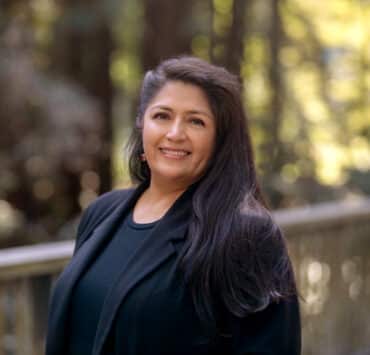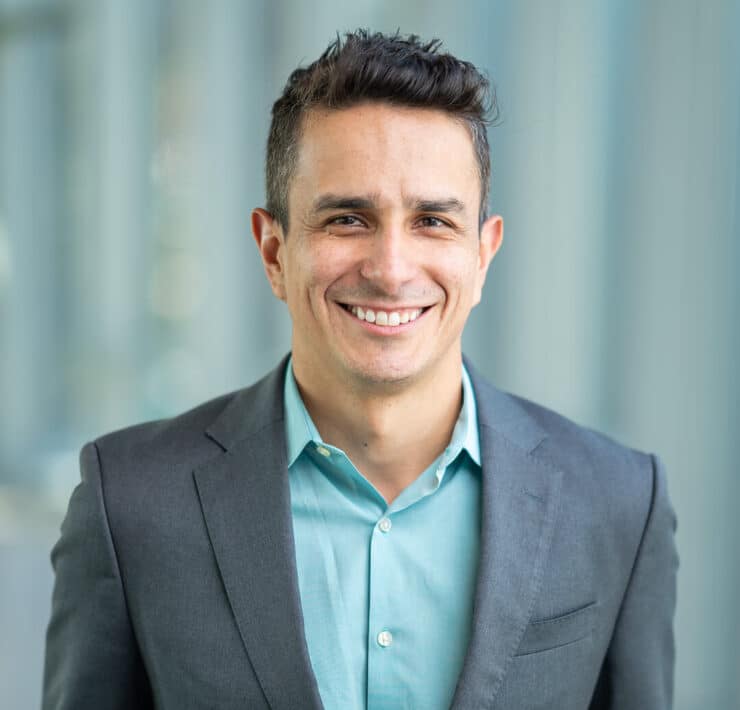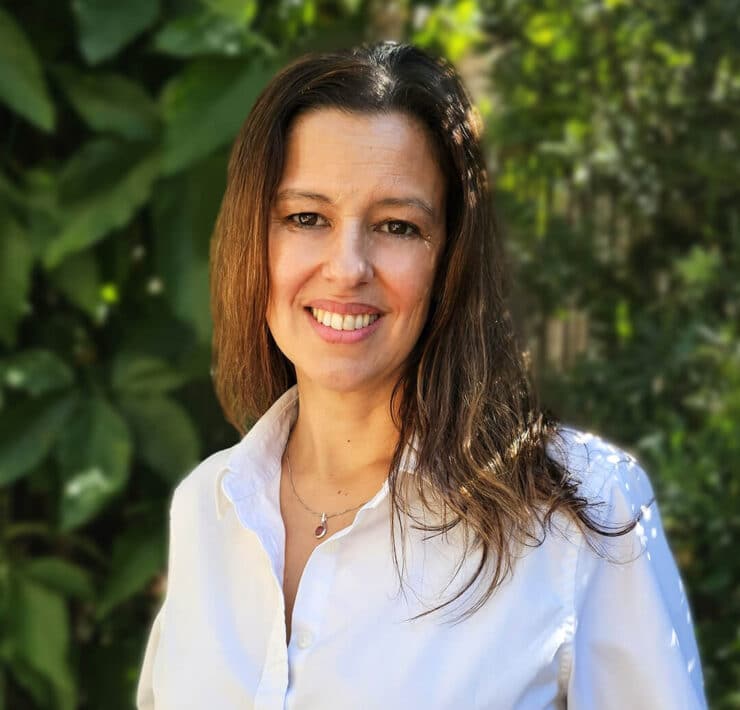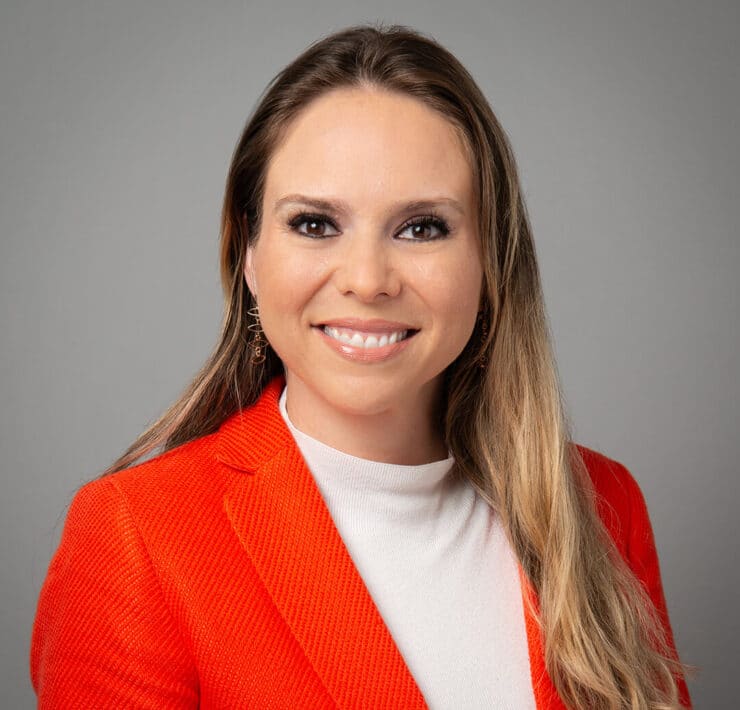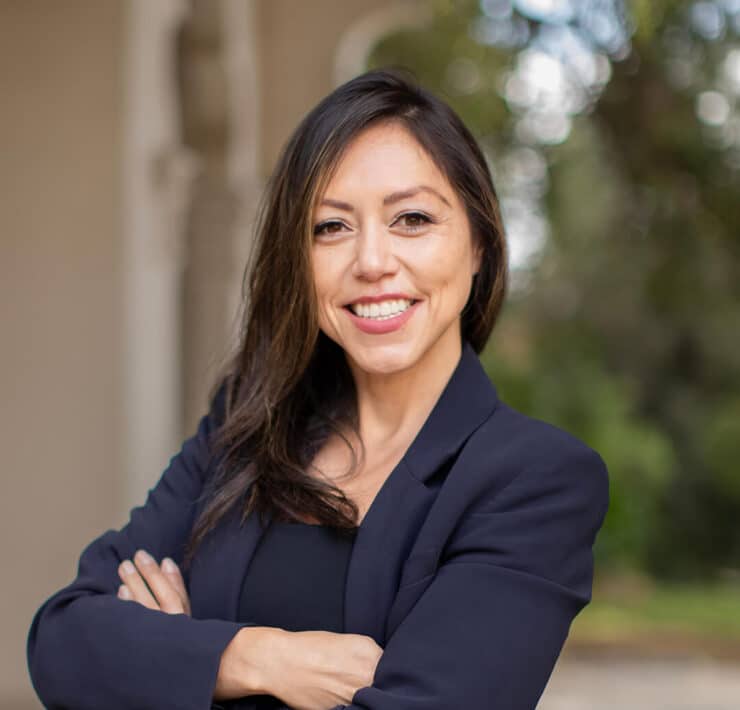Executive to Executive: Liz Caraballo and Maria Smith on the Power of Representation 🎥
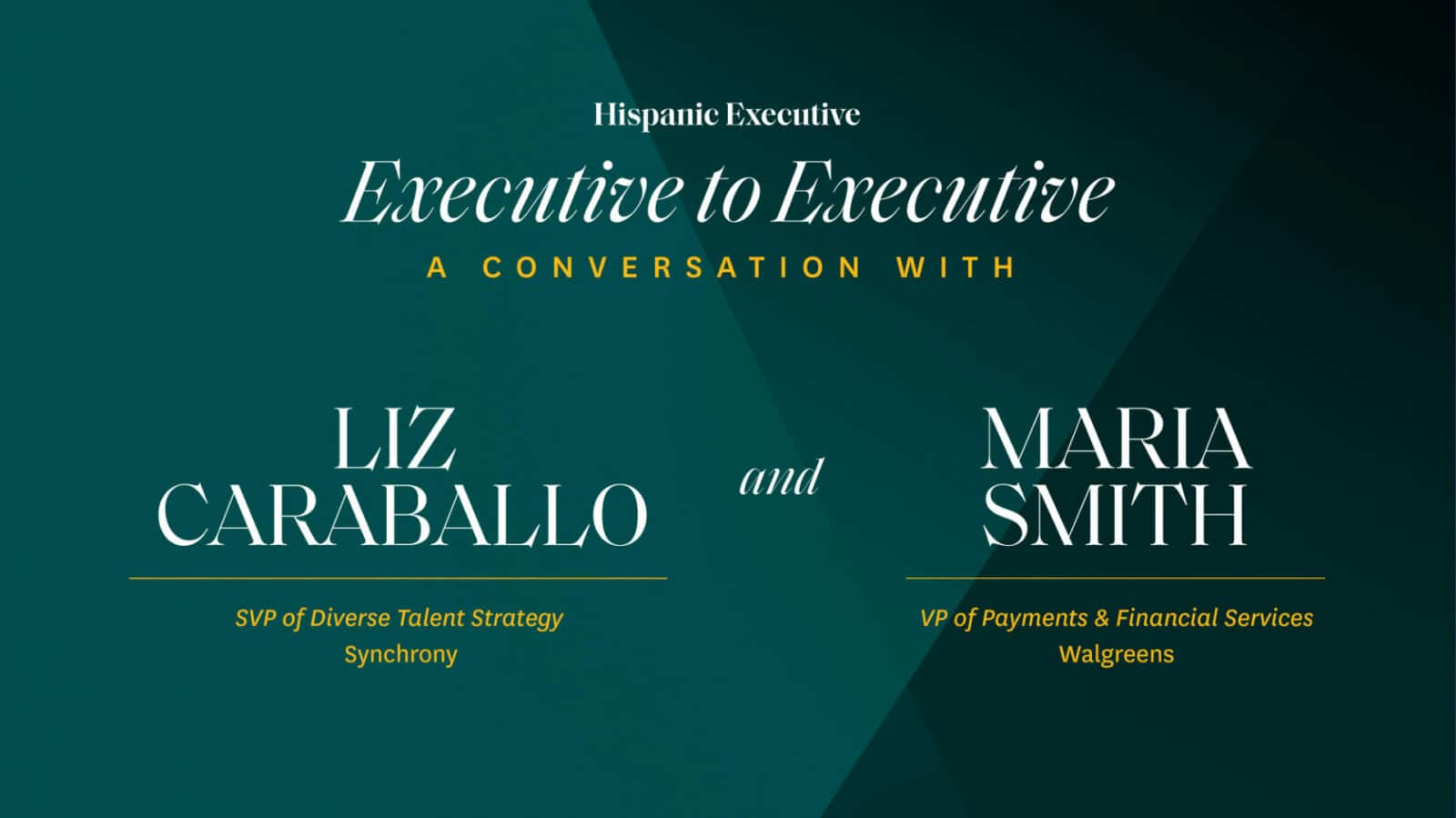
|
Getting your Trinity Audio player ready...
|
When Maria Smith, vice president of payments and financial services at Walgreens, was coming of age, the odds were against her. She was an immigrant, the last of thirteen children, and there was no expectation (nor financial support) for her to go to college. Despite all blockers, Smith did go to college, and after graduating she secured her first job at Disney, which opened many doors at other top corporations including, today, Walgreens. Her journey, not unlike that of many women in corporate America, illustrates the many internal and external hurdles preventing more Latinos for aiming for the highest levels of leadership.
“I’d never allowed myself to dream because no one had shown me that was possible . . . who am I to say that I could be a leader at Disney?” Smith shares candidly with Elizabeth (Liz) Caraballo, the senior vice president of diverse talent strategy at Synchrony, during their executive-to-executive (E2E) interview with Hispanic Executive.
In our E2E series, we put the power of storytelling directly in the hands of remarkable Latinos and Latinas. Through these peer-to-peer conversations, executives like Smith and Caraballo can share key moments from their journeys, inspire future generations, and own the way they share their stories. In turn, our audience gains a line of sight into the executive experience, as well as direct insight into what leaders around the world are really thinking and talking about.
The leaders met through their work with the Latinx Executive Alliance, a coalition of executives and business leaders striving to increase the number of Latinx executives in corporate America, and they share their reflections on everything from work life balance to attracting young talent through a diverse and inclusive company culture.
I’m Liz Caraballo of Synchrony, the diverse talent strategy leader. I’m thrilled and so excited to have with me Maria Smith, vice president of payments and financial services at Walgreens. Thank you for saying yes to this amazing opportunity, and thank you to Hispanic Executive for hosting our discussion today. It’s truly an honor. I’m going to jump right in because I’ve got some great questions that I want to ask you, Maria, and to engage in a peer-to-peer executive conversation today of all things related to breakthrough moments in our careers as Latina executives, and I’m sure the conversation’s going to take us to lots of different places.
Smith: Yeah. Let’s get started!
You have an impressive career, Maria, and I know that as a Latina, it wasn’t easy to get to this level. Walk me through your journey of breaking through the ranks to reach the leadership level that you have today. Not just with Walgreens, but with some amazing brands such as Disney and Starbucks, three amazing brands of which I am a huge fan. I’m so impressed and I know others will be impressed too. Walk us through that journey.
Smith: Well, I think I’ve been very fortunate in my career, but thank you very much. They’re very impressive brands. When I started my career straight out of college, I really didn’t know what I was doing as a Latina, to be honest. I didn’t have anybody to look up to. I didn’t have any way forward. I just imagined myself getting out of college and going to apply for a job that was interesting and fun with good companies. And that’s kind of how I ended up where I ended up. I took some of the basic skills that I had in accounting, and then I had a finance degree and started going after jobs and spaces [where] I thought I would be accepted, to be honest. I was looking for retail jobs in the corporate world, thinking that’s the place that I would go.
And that’s how I started my journey, and then eventually I ended up at Disney. What I’ve done is basically finance, accounting, financial planning and analysis, which is a totally different function. I’ve done a lot of payments work, but I’ve also done accounting operations and business development, and a number of things in the marketing area. I’ve done deals, I’ve done partnership deals, and it’s been an opportunity that was given to me because of hard work. How did I break through these roles? I don’t know (laughs), but I was taught to work hard and just do a good job, and that would be noticed eventually. Then I was lucky enough to have some mentors and sponsors that took me under their wing and helped me get to where I was going.
I was fortunate to spend twenty-one years with Disney and I learned a lot. I moved around doing different jobs and projects because it was exciting work. Honestly, I wasn’t looking for leadership roles again, I wasn’t raised to think that way. Once I got into some of those positions, I found what I really loved and just continued doing that. And then when it came time to choosing another company, Disney’s such an iconic brand. I loved working for the company. It was part of my identity for so long.
When I went to choose another company, I wanted to be with one that had the same kind of representation, which Starbucks had, as does Walgreens, a very great consumer brand representation. I’m lucky to be here, to be honest, and I couldn’t tell you exactly how I did it. I’m happy to answer questions when people ask me as a mentor, but I couldn’t really tell you how I ended up here except for hard work.
Well, they often say that success is “where luck and hard work and preparation meet,” right? True, there is no mistake that the years of service that you put into these companies and your commitment to learning along the way is really what prepared you and hopefully propelled you. But I’m sure that something within you, in terms of your ethic and your character, is really what helped you continue to shine in those opportunities and to be extremely valuable in those brands. So, I would say it’s probably a little bit more than luck, Maria.
Smith: Oh, thank you. I think I did say that. I don’t like speaking about myself but, one thing that you said reminded me that one of the things that did propel me is when people say that you can’t do something. I think that when I was asked to do things that appeared to be a challenge, it was a little bit of a I-couldn’t-do-it situation. I needed to prove that I could. That was a little bit of my personality.
Now it’s coming.
Smith: Oh, yeah! That’s a little bit of why I think I ended up doing many of the things that I had done. I was offered an opportunity to do it, thinking it was a challenge, and that maybe it wasn’t common for me to do that. I thought I should do it because I was challenged to do it.
I love it, and you rose to the occasion. Let’s talk about it from an executive level. When was that moment in your life or career when you realized that becoming an executive was the path that you wanted to take? And you touched on this a little bit in terms of how these opportunities have played out for you but, for example, I remember when I thought I was ready to be an executive versus when I was really, truly ready. And by the way, there were a few years in between when I thought I was ready versus when I really was. So, I’m interested to hear about your story in terms of when did you know for sure that you wanted to be an executive? Were there any processes or tools or techniques? You mentioned mentorship and sponsorship already, which I’m assuming is going to be part of your journey as it is for so many of us, especially those of us who don’t have family and parents who could pave the way for us. Latinas and Latinos, we kind of figure this out sometimes the hard way, so I’m interested in hearing about your journey to becoming an executive.
Yeah. That was interesting when you said the moment you thought you were ready versus when you were actually ready. For me, it was the moment that I allowed myself to dream that I could do something and rise to the executive branches of . . . I think it was Disney. I remember the moment sitting with my then-spouse talking about what it would mean for our family if I really did propel myself forward. Wishing to be something beyond a manager level–that was the first thing. It was the moment that I saw the breadth of Disney and the company that it was. And, again, I’d never allowed myself to dream because no one had showed me that, that was possible. I mean, here I am a young, first-generation immigrant that came to this country when I was three, and who am I to say that I could be a leader at Disney? It was that moment that I said, “Okay, I really want to dream it.”
Then I had the conversation with my then-spouse to say, “what would it take to do it?” And what was really interesting was then telling my mom or trying to educate my family about how to do it. I came from a large family of thirteen. I’m number thirteen, so in order to allow myself to do that, I had to really explain what it meant to be an executive or to have a more meaningful job with them. Especially when I had young children. She always questioned why I wasn’t home by five every day, or why my schedule was so grueling.
It was really that moment that I said, this is what I want to do, and these are the things I have to do, and I need the help from my mother, and at the time my spouse, to get it done. I think one of the other things that was important at that time for me was being vulnerable to ask for help. I didn’t know how to get there. I knew I wanted to do it, and I knew that I needed to rise to certain levels, but of course, I didn’t aspire to be a certain level. I just aspired to do a good job. But when I didn’t know what to do, back to the mentors and sponsors, I allowed myself the opportunity to say, “I don’t know how to do this. Can you help me?” And that actually gave me a big step up to be honest, because I didn’t have it in my family.
And I love this, this conversation and us being vulnerable with each other. I’d love to share that the time I thought I was ready, ironically coincides with the year that I got divorced.
Oh.
The universe must have known that it wasn’t the right time for me, both professionally and personally. I went through the divorce, continued to work really hard, and I had the dream. I really did have the dream. I just didn’t realize that everything has to align and be in the right timing: right role, right opportunity, right person. I didn’t get it until a few years later after the divorce as a single mom, knowing that I needed a lot of support, but I had the support of my now ex-husband helping to care for the kids and to balance all of those things that you talked about. I’ve had very similar challenges in my journey, but once I got to that level, I knew that I was ready. I knew that I was more than ready, and coupled with the dream, I continued to propel and push myself.
Now my sons are graduated from college and independent and doing their best, and living their best lives. I’m really, really proud. I’m proud of the journey because it wasn’t easy. As we talked about in that first question, it’s not like some people perceive it, like “Oh, wow. Of course, Maria’s going to be like, ‘Look at the package.’” But it’s hard. It’s hard. It’s a lot to balance, and it’s a lot to really keep all those important balls in the air.
Smith: Yeah, exactly. And can I say, congratulations to you! Because I think that when the opportunity is there, we rise to the occasion. I really do feel that, and part of it is our upbringing. I don’t know about you, but I was brought up to be tough and to do what I needed to do and get stuff done. Sometimes that didn’t help very much because I’m very independent. It helped me be successful in my executive world, but sometimes not in my personal life. But good for you for doing that. And doesn’t it feel great to say that with all that and what you’ve done, that your children are doing well and thriving? Because I’ve got two daughters, you’ve got two sons. I have two daughters who are also thriving, and I’m so proud of them.
And my whole goal in working was, not even achieving executive status, but that they had a better life than I did. At the end of the day, it wasn’t about the money or the title, or what I did, or what I achieved, it’s that my children would have a better life than I did. That’s right. And I’m proud to say that I’ve succeeded in giving them that, at least in their childhood. Now, as adult women, they’ve had opportunities and role models to do things that others hadn’t done for me or my family. I’m very proud of that, and you’ve done that for your sons.
Congratulations! I think that’s amazing. A very similar goal I want is to do for them what couldn’t be done for me in terms of paving a path. And someone in your ear telling you anything is possible as long as you’re willing to dream big and work hard for it.
I’m so inspired. Speaking of balance and keeping it all together, I know that it’s hard even still, right? We do have adult children, but we still have a lot of demands. The higher you go in the organization and the deeper you get into your career, the greater the responsibility. And I do believe that to whom much is given, much is expected. So, I remind myself of that every single day.
As you think about personal and professional and how that all comes together, can you share a little bit about what you do to keep a healthy mindset and wellbeing at the forefront of your list of priorities? One of the things that I did five years ago was I had put my health and wellness to the side. I was so focused on my son, so focused on my career, I wasn’t living my best healthy life in terms of mind, body, and spirit. Exercise had always been important to me, but in terms of the commitment of, ‘I’m going to do this four days a week,’ it was up and down. I recommitted myself to do that five years ago. And now it’s the very first thing I do. Five o’clock or six o’clock in the morning. That is my time. I’m going to work out. I’m not going to think about work, I’m not going to think about anything or anyone except for getting this routine in. So, for me, that was one way. What are some of the examples that you might have in terms of how you commit yourself to your wellbeing?
Smith: Like you, I do think about my physical health as one important thing but, honestly, what was harder for me early on was to shift my brain from thinking about others—because I was raised as a Latina to think about others first. You take care of your parents, you take care of others, you are just nurturers. With my children being young, and when I was married, I was always doing for others. When I finally could focus on myself, as you shared, I thought the first thing was physical and mental health. How do I do that for myself and for my children? Again, that’s the part that’s still hard to let go of.
Me being a physically healthy person is also about my children. But to your point, I said, “Okay, what are the things that I want to focus on for myself?” In terms of the physical nature of it, but also enjoyment–I do a number of things that get me away from my desk and that de-stress me from the job. During the pandemic, it was certain classes. I left my desk because it could have been like a twenty-four-hour job, a full-day job. During the pandemic that was the sometimes the case. I left my desk to take organized classes, or I had certain commitments of the week that I made for myself, but I would do certain activities. I am currently still doing those, anywhere from going to the gym to biking. I took sailing lessons this summer and just doing a lot of interesting things that I think make me a more interesting person, and also allow me to destress in that moment, if you will, and to include physical activity.
It’s a combination of those things. But that wasn’t enough, because the other thing that I did – and maybe you’ve done this in your career as well – when we have these types of jobs, it is very demanding, and we put in a lot of time and effort in during the week. And when I didn’t have my children to pull me away from the office, I was spending more time at the office. On the weekends, I ended up doing more work. I j made a conscious effort at a certain point to say, “Look, I won’t work weekends.” I mean, sometimes you have to, obviously, and you do. But it was a constant before, where I had a weekend in there. Like, you get back to work on Sundays, it’s just what you do. Now my personal commitment beyond my physical wellness is also not to focus on work during the weekends. Now if I have to, I do it and that’s great. I will commit to it, and I will deliver. But I try not to send emails to my team. I try not to answer emails. Now, occasionally I get emails that are very important that I have to respond (laughs). That is still the job, but that’s not the thing that I do for myself, because I do feel like pulling away from a stressful job is really important for all of us in terms of balance.
I totally agree. Boundaries. You’re so right
Totally. And, so, for me, weekends are a boundary. I got engaged last year and . . .
Smith: Congratulations.
Thank you. My now-fiancé helps to keep me honest and says, “it’s time to log off and spend some time together.” And, it’s good to have people, right? People who are going to keep you accountable, especially when the kids are gone, and you have the empty nest. Because I can really, now that I’m living in Florida and my kids are in Atlanta and in New Jersey. It’s easy to allow yourself to be so consumed, especially if you love what you do. I’m sure you do. It’s real easy, but you do need to put up those boundaries. They are so important, and I think it helps you come back into the office on Monday with a fresh new perspective and outlook. It really does for everybody.
Smith: Yeah, it really does. And I think it’s a really important representation to your team to say that these things are important. It depends on who their supervisors were in the past and who their role models were in the past, but sometimes they believe that is the only way to get to the successful careers. . . to spend a lot of time in the office. So, it’s a really important thing. I know we say it to our teams, but I think we need to demonstrate it as well.
And resisting that email at nine o’clock on a Sunday night; not responding. Because if you respond exactly right then, others feel like they have to respond too.
Smith: That’s exactly it. . I would send emails back and then they would be waiting for emails from me over the weekend. That’s not fair either. So, yes, I agree. You really do have to resist that. It’s important.
Awesome. So now I want to switch gears a little bit and talk about the Latinx Executive Alliance, which is where you and I got to meet and start to engage via our shared interests and desire to really help advance Latinx talent into executive level roles, which is where the idea of the Latinx Executive Alliance came from.
You were so instrumental in helping us think through the need and the gap and what we could, as organizations, do about it. The Latinx Executive Alliance is really focused on helping to move the needle and bringing thought leaders from various industries and organizations to help address the visible gap in representation at the executive level. I know I don’t need to tell you, we represent 19 percent of the general population, and yet only 4 percent of Latinos are in a level of decision-making, like an executive level, like our roles. There’s just not enough. We need more decision makers that represent the communities and represent the customers that we serve. I know for all those reasons, you’re committed to the Latinx Executive Alliance, but I would love to hear in your words about the commitment and why it’s important to you. Why it’s important to Walgreens to be a part of this movement.
Smith: I briefly mentioned it before about what was important for me, that there was no representation for me. There was no one that looked like me or that I could talk to about this. And I do feel like, as we know, all of the Latinx executives and people are not the same. People like to put us into one group, but we’re not the same. And I feel like I might be a little bit more unique than others. I’m an immigrant that wasn’t born here. Also, coming from Mexican parents who also didn’t push education. The fact that I ended up in college was, sort of, the same thing. They told me I couldn’t so then I said, “Okay, I will.” I feel like a lot of what I’ve gone through has been a bit different than others.
If I could be a little bit different than all the other representatives on the Latinx Executive Alliance, then I think that it might be helpful to that one unique person that feels like they don’t have the confidence or the ability to lean into being an executive. I allowed myself the ability to wish for it, to dream about it, but no one gave it to me. So, if I as an individual, as awkward as I can be, can achieve this, anyone can. I achieved the career that I have and however I was driven, if I look like someone and they can say, “Look, if she can do it, I can do it,” I think that is really important. That’s why I participate in it. In terms of Walgreens, I’m very impressed with the culture and just the importance that we’ve placed on diversity and inclusivity.
It’s really important to the company that we have diversity, that we represent in our support center and in all of our leadership roles the communities we serve, because we serve so many different communities. I think that’s been a big piece of why I joined Walgreens. There’s a good brand doing good things for the company, but it’s also very important that we represent the communities that we serve. I’m part of that. There’s a lot of Latin communities that Walgreens empowers. I think that is important.
Well, thank you for joining us on this journey and serving as one of our board of advisors. We will continue to evolve and iterate and offer the key fundamentals that we know were important to our careers: mentoring, sponsorship, thought leadership, and access to resources. What I think is most important is the role model. You can’t believe what you can’t see. If Maria Smith isn’t at Walgreens, or if Liz Caraballo isn’t at Synchrony, why should others believe that it’s possible? I’m so thankful that you’re on this journey with us.
We’re both extremely fortunate to work for companies like Walgreen and Synchrony that are deeply committed to diversity, equity, and inclusion. So much so, in terms of Synchrony’s commitment, my position didn’t exist over a year ago. It’s such a unique position, because it’s the bridge between our diversity office – where we focus on looking at the data that tells us where we are lacking in the representation that we want to see at our company – and the talent team. I get to look at every milestone of the talent journey from the view of diverse talent. Where are we going to find the talent that we need when we find them? How are we going to welcome them and onboard them? How are we going to continue to invest in them and develop them? And all the way through retention.
Can you talk a little bit about Walgreen’s commitment to this journey, so that as we represent our companies and their brands’ in this conversation, we can share a little bit about what is best-in-class in terms of this commitment? It’s one thing to say we’re champions of diversity and another to put positions like mine in place as an ERG [environmental, regulatory, and governance] leader. To commit resources and leadership ERGs that are doing great work in our companies on the topic of diversity. Because it cannot just be the chief diversity officer’s role, one person’s mantra. It’s everybody from top to bottom and then everybody in between really living and breathing it on a day-to-day basis.
Smith: Exactly. When I interviewed at Walgreens, I asked about diversity because, to be honest, I had no understanding of the culture of Walgreens until I started my journey considering a job here. But what I learned was that they did have a strong commitment and had for years, and there was a chief diversity officer. There’s also a number of things that [Walgreens] has done. , I’ve been with a number of companies, you mentioned some that I worked with or some that you didn’t mention that I won’t name now, but that have also made commitments to some of these goals. What’s different about Walgreens is they’ve made commitments and put goals out there. For example, they’ve said they want women in leadership roles and have put a goal into how much they’re increasing the number of women in leadership roles.
They’ve said they’re going to put people of color in leadership roles and put a goal out there, then they’ve come back and reported against it. Clear transparency against that. And so that’s pretty unique in some areas. I think Synchrony does a really good job with that as well. But a lot of companies really just say that they want to do it, but don’t give their teams the tools to do it. In our group when we’re interviewing we have that diversity of talent to interview the candidates that have the right skills and we also have very diverse opportunities, It’s these that are a very important part of our hiring process. But not only that, that’s really like a leadership role, which is very important, right? If you want to reflect the team that you’re going to hire, you need to have the leaders that reflect that.
Walgreens has also increased diversity into our Board of Directors. That’s been very important as well as our suppliers. We’ve demanded it from the suppliers that we work with. We’re changing the system around us, not only with what we’re doing at Walgreens, and that’s very important. Finally, we’re providing the tools for the team. You mentioned a couple of things too. We’ve done some unconscious bias training and that’s been prevalent for a number of years, as well as provide those tools that the different resource groups need for different levels of inclusivity, be it organizations for Hispanics or African Americans or LGBTQ+ employees, that’s been provided as well. I’d have to say that that’s pretty commonplace now. But the devotion that the company has made and the commitment that they have made, and to be transparent, to show that we have we done what we said we’re going to do, I think that is kind of unique.
That’s what makes me proud to work for Walgreens. It’s about representation for the communities that we serve, but it’s really also saying that our leadership team has said they’re going to do it. They’ve given goals and said, here’s how we’re doing against it. Part of our performance bills are all based on it as a leadership team –so that’s really important as well. Then we report on it for transparency purposes; I think that’s the best that we can do in that case. That’s a really good benchmark for other companies to follow.
It just goes beyond talking about it, but it’s showing that the conversation continues as you look at the data and the transparency around it. Looking at the board and looking at each of those levels of leadership, and asking yourself, does it really, truly reflect the diversity that you’re trying to bring into the company? Then having honest conversations. I don’t know that there’s a perfect company doing this, but it’s great to be a part of a culture and a leadership team that believes that it’s the right thing to do. And that we’re going to put forth the energy and resources around it, especially if we’re going to win the hearts of talent. My youngest son who graduated from college earlier this year was interviewing for roles and one of his primary questions was around culture and commitment to diversity. As a diverse male, he wanted to know that he was going into a culture that was going to be supportive of him. I’m so proud of him; he turned down the first job offer he got.
Smith: Really? He didn’t like the answer he got.
They admittedly said that this was something they were working on, but they didn’t really have anything in place, and he thought, “Wow, onto the next opportunity.”
Smith: Good for him. But yeah, that is true for young people. And my daughters are in the same situation, but they’re also causing the change at their levels. Love it. My oldest daughter actually works for Disney at the moment, and so she does have the opportunity to participate in the necessary changes.
But what’s really important is that we’re telling other future leaders what’s important, what matters, and how to get it done. These young people going into roles are also demanding that the company already show proof that they’re getting there. I know culture is a really big question that you ask in interviewing and one thing I’ve learned in my career is that you can’t ask the people you’re interviewing about the culture. You almost have to ask other people around them. I don’t know if you’ve ever done that, but I’ve had a number of people that we’re interviewing for positions at companies that I’ve been to before call me and ask me about culture. If they didn’t know me, they were introduced to me from people on LinkedIn that were part of my network. So now we’re in such a social environment and it’s such easy networking environment that people can ask those folks that work directly in the companies how it really works. I can hear everything from the interviewers, but they may not believe it and they want to hear it from folks that have actually been there.
I’ve had candidates say to me, I’ve done my research, I’ve tried to turn every stone and here’s what I know, or here’s what I’ve learned about Synchrony. And almost say, “Hey, it sounds too good to be true.” And then once they’re here they realize it’s true. It’s a strong and developing culture. There’s still always room for change and improvement, but we are the culture we say we are. And so that’s that. I get very proud just talking about that.
Well, thank you so much Maria, for this amazing time that we’ve shared here together. And getting to know you a little bit better. And hopefully our listeners by way of Hispanic Executive will also get inspired by this conversation and know that no two paths are exactly alike, but that hard work, perseverance, a little bit of luck sprinkled in there, great mentors and sponsors, great company cultures: all of these things matter and they’re so important for our overall success. So, thank you again and I wish you all the best.
Smith: Well, thank you for having me. So excited to be talking to you, Liz, and thank you for your partnership as well on the myWalgreens credit card. I wanted to mention that as well.
Exactly. This is another great way to show how our partnership can go and extend beyond our day-to-day, into very important topics.
Smith: Exactly. Another role model for how companies can work well together. Thank you for having me, and thank you to Hispanic Executive, as well.
This interview has been edited for clarity.

